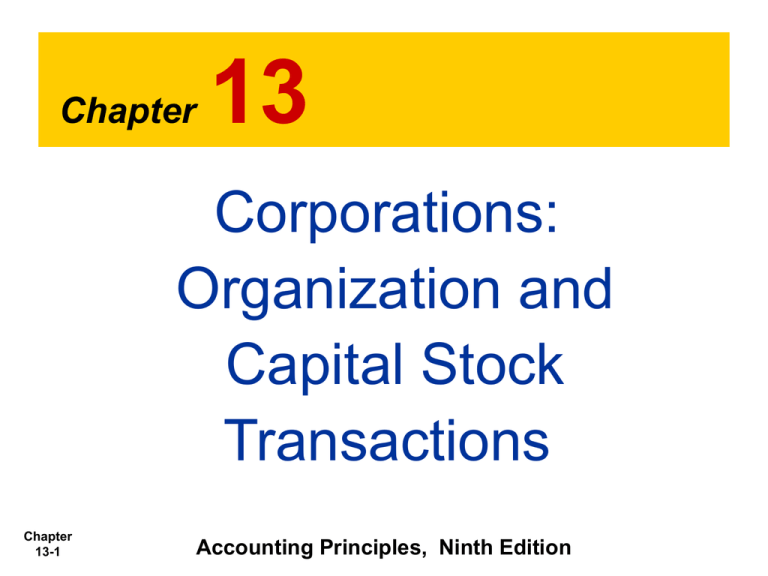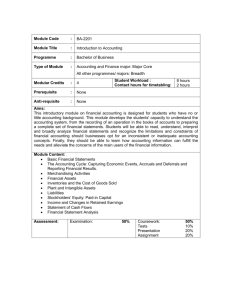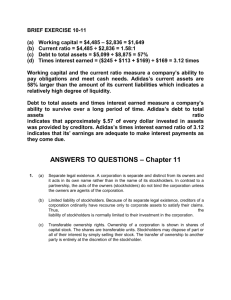
Chapter
13
Corporations:
Organization and
Capital Stock
Transactions
Chapter
13-1
Accounting Principles, Ninth Edition
Study Objectives
1.
Identify the major characteristics of a corporation.
2. Differentiate between paid-in capital and retained
earnings.
3. Record the issuance of common stock.
4. Explain the accounting for treasury stock.
5. Differentiate preferred stock from common stock.
6. Prepare a stockholders’ equity section.
Chapter
13-2
Corporations: Organization and Capital
Stock Transactions
The Corporate
Form of
Organization
Accounting
for Common
Stock Issues
Accounting
for Treasury
Stock
Characteristic
s
Issuing par
value stock
Formation
Issuing nopar stock
Purchase of
treasury
stock
Stockholder
rights
Stock issue
considerations
Corporate
capital
Chapter
13-3
Issuing stock
for services
or noncash
assets
Disposal of
treasury
stock
Preferred
Stock
Statement
Presentation
Dividend
preferences
Capital stock
Liquidation
preference
Additional
paid-in capital
Retained
earnings
The Corporate Form of Organization
An entity separate and distinct from its owners.
Classified by Purpose
Not-for-Profit
Publicly held
For Profit
Privately held
Salvation Army
American Cancer
Society
Gates Foundation
Chapter
13-4
Classified by Ownership
McDonald’s
Ford Motor Company
PepsiCo
Google
Cargill Inc.
Characteristics of a Corporation
Characteristics that distinguish corporations from
proprietorships and partnerships.
Separate Legal Existence
Limited Liability of Stockholders
Transferable Ownership Rights
Ability to Acquire Capital
Advantages
Continuous Life
Government Regulations
Additional Taxes
Disadvantages
Corporate Management
Chapter
13-5
SO 1 Identify the major characteristics of a corporation.
Characteristics of a Corporation
Characteristics that distinguish corporations from
proprietorships and partnerships.
Separate Legal Existence
Limited Liability of Stockholders
Transferable Ownership Rights
Ability to Acquire Capital
Corporation acts
under its own name
rather than in the
name of its
stockholders.
Continuous Life
Government Regulations
Additional Taxes
Corporate Management
Chapter
13-6
SO 1 Identify the major characteristics of a corporation.
Characteristics of a Corporation
Characteristics that distinguish corporations from
proprietorships and partnerships.
Separate Legal Existence
Limited Liability of Stockholders
Transferable Ownership Rights
Limited to their
investment.
Ability to Acquire Capital
Continuous Life
Government Regulations
Additional Taxes
Corporate Management
Chapter
13-7
SO 1 Identify the major characteristics of a corporation.
Characteristics of a Corporation
Characteristics that distinguish corporations from
proprietorships and partnerships.
Separate Legal Existence
Limited Liability of Stockholders
Transferable Ownership Rights
Ability to Acquire Capital
Shareholders may
sell their stock.
Continuous Life
Government Regulations
Additional Taxes
Corporate Management
Chapter
13-8
SO 1 Identify the major characteristics of a corporation.
Characteristics of a Corporation
Characteristics that distinguish corporations from
proprietorships and partnerships.
Separate Legal Existence
Limited Liability of Stockholders
Transferable Ownership Rights
Ability to Acquire Capital
Continuous Life
Government Regulations
Corporation can
obtain capital
through the
issuance of stock.
Additional Taxes
Corporate Management
Chapter
13-9
SO 1 Identify the major characteristics of a corporation.
Characteristics of a Corporation
Characteristics that distinguish corporations from
proprietorships and partnerships.
Separate Legal Existence
Limited Liability of Stockholders
Transferable Ownership Rights
Ability to Acquire Capital
Continuous Life
Government Regulations
Additional Taxes
Corporate Management
Chapter
13-10
Continuance as a
going concern is not
affected by the
withdrawal, death,
or incapacity of a
stockholder,
employee, or
officer.
SO 1 Identify the major characteristics of a corporation.
Characteristics of a Corporation
Characteristics that distinguish corporations from
proprietorships and partnerships.
Separate Legal Existence
Limited Liability of Stockholders
Transferable Ownership Rights
Ability to Acquire Capital
Continuous Life
Government Regulations
Additional Taxes
Corporate Management
Chapter
13-11
SO 1 Identify the major characteristics of a corporation.
Characteristics of a Corporation
Characteristics that distinguish corporations from
proprietorships and partnerships.
Separate Legal Existence
Limited Liability of Stockholders
Transferable Ownership Rights
Ability to Acquire Capital
Continuous Life
Government Regulations
Additional Taxes
Corporate Management
Chapter
13-12
Corporations pay
income taxes as a
separate legal entity
and in addition,
stockholders pay
taxes on cash
dividends.
SO 1 Identify the major characteristics of a corporation.
Characteristics of a Corporation
Characteristics that distinguish corporations from
proprietorships and partnerships.
Separate Legal Existence
Limited Liability of Stockholders
Transferable Ownership Rights
Ability to Acquire Capital
Continuous Life
Government Regulations
Additional Taxes
Corporate Management
Chapter
13-13
Separation of
ownership and
management prevents
owners from having
an active role in
managing the
company.
SO 1 Identify the major characteristics of a corporation.
Characteristics of a Corporation
Stockholders
Illustration 13-1
Corporation
organization chart
Chairman and
Board of
Directors
President and
Chief Executive
Officer
General
Counsel and
Secretary
Vice President
Marketing
Treasurer
Chapter
13-14
Vice President
Finance/Chief
Financial Officer
Vice President
Operations
Vice President
Human
Resources
Controller
SO 1 Identify the major characteristics of a corporation.
Forming a Corporation
Initial Steps:
File application with the Secretary of State.
State grants charter.
Corporation develops by-laws.
Companies generally incorporate in a state whose laws
are favorable to the corporate form of business
(Delaware, New Jersey).
Corporations expense organization costs as incurred.
Chapter
13-15
SO 1 Identify the major characteristics of a corporation.
Ownership Rights of Stockholders
Stockholders have the right to:
Illustration 13-3
1. Vote in election of board of
directors and on actions that
require stockholder approval.
2. Share the corporate earnings
through receipt of dividends.
Chapter
13-16
SO 1 Identify the major characteristics of a corporation.
Ownership Rights of Stockholders
Stockholders have the right to:
Illustration 13-3
3. Keep the same percentage ownership when new
shares of stock are issued (preemptive right*).
* A number of companies have eliminated the preemptive right.
Chapter
13-17
SO 1 Identify the major characteristics of a corporation.
Ownership Rights of Stockholders
Stockholders have the right to:
Illustration 13-3
4. Share in assets upon liquidation in proportion to
their holdings. This is called a residual claim.
Chapter
13-18
SO 1 Identify the major characteristics of a corporation.
Ownership Rights of Stockholders
Prenumbered
Illustration 13-4
Class
Class A
Class A
COMMON STOCK
COMMON STOCK
PAR VALUE
$1 PER SHARE
PAR VALUE
$1 PER SHARE
Name of corporation
Stockholder’s name
Stock Certificate
Shares
Signature of
corporate official
Chapter
13-19
SO 1 Identify the major characteristics of a corporation.
Stock Issue Considerations
Authorized Stock
Charter indicates the amount of stock that a
corporation is authorized to sell.
Number of authorized shares is often reported
in the stockholders’ equity section.
Chapter
13-20
SO 1 Identify the major characteristics of a corporation.
Stock Issue Considerations
Issuance of Stock
Corporation can issue common stock directly to
investors or indirectly through an investment
banking firm.
Factors in setting price for a new issue of stock:
1. the company’s anticipated future earnings
2. its expected dividend rate per share
3. its current financial position
4. the current state of the economy
5. the current state of the securities market
Chapter
13-21
SO 1 Identify the major characteristics of a corporation.
Stock Issue Considerations
Market Value of Stock
Stock of publicly held companies is traded on
organized exchanges.
Interaction between buyers and sellers determines
the prices per share.
Prices set by the marketplace tend to follow the
trend of a company’s earnings and dividends.
Factors beyond a company’s control, may cause dayto-day fluctuations in market prices.
Chapter
13-22
SO 1 Identify the major characteristics of a corporation.
Chapter
13-23
Stock Issue Considerations
Par and No-Par Value Stock
Years ago, par value determined the legal capital
per share that a company must retain in the
business for the protection of corporate creditors.
Today many states do not require a par value.
No-par value stock is quite common today.
In many states the board of directors assigns a
stated value to no-par shares.
Chapter
13-24
SO 1 Identify the major characteristics of a corporation.
Corporate Capital
Common Stock
Paid-in Capital
Account
Preferred Stock
Paid-in Capital in
Excess of Par
Account
Account
Two Primary
Sources of
Equity
Retained Earnings
Account
Paid-in capital is the total amount of cash and other assets
paid in to the corporation by stockholders in exchange for
capital stock.
Chapter
13-25
SO 2 Differentiate between paid-in capital and retained earnings.
Corporate Capital
Common Stock
Paid-in Capital
Account
Preferred Stock
Additional Paidin Capital
Account
Account
Two Primary
Sources of
Equity
Retained Earnings
Account
Retained earnings is net income that a corporation retains
for future use.
Chapter
13-26
SO 2 Differentiate between paid-in capital and retained earnings.
Corporate Capital
Comparison of the owners’ equity (stockholders’
equity) accounts reported on a balance sheet for a
proprietorship, a partnership, and a corporation.
Illustration 13-6
Chapter
13-27
SO 2 Differentiate between paid-in capital and retained earnings.
Accounting for Common Stock Issues
Primary objectives:
1) Identify the specific sources of paid-in capital.
2) Maintain the distinction between paid-in capital
and retained earnings.
Other than consideration received, the
issuance of common stock affects only
paid-in capital accounts.
Chapter
13-28
SO 3 Record the issuance of common stock.
Accounting for Common Stock Issues
Issuing Par Value Common Stock for Cash
Illustration: Assume that Hydro-Slide, Inc. issues 1,000
shares of $1 par value common stock at par for. Prepare the
journal entry.
Cash
1,000
Common stock (1,000 x $1)
Chapter
13-29
1,000
SO 3 Record the issuance of common stock.
Accounting for Common Stock Issues
Issuing Par Value Common Stock for Cash
Illustration: Assume that Hydro-Slide, Inc. issues 2,000
shares of $1 par value common stock. Prepare Hydro-Slide’s
journal entry if (a) 1,000 share are issued for $1 per share,
and (b) 1,000 shares are issued for $5 per share.
a.
Cash
1,000
Common stock (1,000 x $1)
b.
Chapter
13-30
Cash
1,000
5,000
Common stock (1,000 x $1)
1,000
Paid-in capital in excess of par value
4,000
SO 3 Record the issuance of common stock.
Accounting for Common Stock Issues
Illustration 13-7
Chapter
13-31
SO 3 Record the issuance of common stock.
Accounting for Common Stock Issues
Issuing Common Stock for Services or
Noncash Assets
Corporations also may issue stock for:
Services (attorneys or consultants).
Noncash assets (land, buildings, and equipment).
Cost is either the fair market value of the consideration
given up, or the fair market value of the consideration
received, whichever is more clearly determinable.
Chapter
13-32
SO 3 Record the issuance of common stock.
Accounting for Common Stock Issues
Illustration: Assume that attorneys have helped Jordan
Company incorporate. They have billed the company $5,000
for their services. They agree to accept 4,000 shares of $1
par value common stock in payment of their bill. At the time
of the exchange, there is no established market price for the
stock. Prepare the journal entry for this transaction.
Organizational expense
Chapter
13-33
5,000
Common stock (4,000 x $1)
4,000
Paid-in capital in excess of par
1,000
SO 3 Record the issuance of common stock.
Accounting for Common Stock Issues
Illustration: Assume that Athletic Research Inc. is an
existing publicly held corporation. Its $5 par value stock is
actively traded at $8 per share. The company issues 10,000
shares of stock to acquire land recently advertised for sale
at $90,000. Prepare the journal entry for this transaction.
Land (10,000 x $8)
Chapter
13-34
80,000
Common stock (10,000 x $5)
50,000
Paid-in capital in excess of par
30,000
SO 3 Record the issuance of common stock.
Accounting for Treasury Stock
Common Stock
Paid-in Capital
Account
Preferred Stock
Paid-in Capital in
Excess of Par
Account
Account
Two Primary
Sources of
Equity
Retained Earnings
Account
Less:
Treasury Stock
Account
Chapter
13-35
SO 4 Explain the accounting for treasury stock.
Accounting for Treasury Stock
Treasury stock - corporation’s own stock that it
has reacquired from shareholders, but not retired.
Corporations purchase their outstanding stock:
1. To reissue the shares to officers and employees under
bonus and stock compensation plans.
2. To enhance the stock’s market value.
3. To have additional shares available for use in the
acquisition of other companies.
4. To increase earnings per share.
5. To rid the company of disgruntled investors, perhaps to
avoid a takeover.
Chapter
13-36
SO 4 Explain the accounting for treasury stock.
Accounting for Treasury Stock
Purchase of Treasury Stock
Debit Treasury Stock for the price paid to
reacquire the shares.
Treasury stock is a contra stockholders’ equity
account, not an asset.
Purchase of treasury stock reduces
stockholders’ equity.
Chapter
13-37
SO 4 Explain the accounting for treasury stock.
Accounting for Treasury Stock
Illustration 13-8
Illustration: On February 1, 2008, Mead acquires 4,000
shares of its stock at $8 per share.
Treasury stock (4,000 x $8)
Cash
Chapter
13-38
32,000
32,000
SO 4 Explain the accounting for treasury stock.
Accounting for Treasury Stock
Stockholders’ Equity with Treasury stock
Illustration 13-9
Both the number of shares issued (100,000), outstanding (96,000), and
the number of shares held as treasury (4,000) are disclosed.
Chapter
13-39
SO 4 Explain the accounting for treasury stock.
Accounting for Treasury Stock
Sale of Treasury Stock
Above Cost
Below Cost
Both increase total assets and stockholders’
equity.
Chapter
13-40
SO 4 Explain the accounting for treasury stock.
Above
Cost
Accounting for Treasury Stock
Illustration: On February 1, 2008, Mead acquires 4,000
shares of its stock at $8 per share. Record the journal
entry for the following transaction:
On July 1, Mead sells for $10 per share 1,000 shares of its
treasury stock, previously acquired at $8 per share.
July 1
Cash
10,000
Treasury stock
Paid-in capital treasury stock
8,000
2,000
A corporation does not realize a gain or suffer a loss from stock
transactions with its own stockholders.
Chapter
13-41
SO 4 Explain the accounting for treasury stock.
Below
Cost
Accounting for Treasury Stock
Illustration: On February 1, 2008, Mead acquires 4,000
shares of its stock at $8 per share. Record the journal
entry for the following transaction:
On Oct. 1, Mead sells an additional 800 shares of treasury
stock at $7 per share.
Oct. 1
Cash
5,600
Paid-in capital treasury stock
Treasury stock
800
6,400
Mead uses Paid-in Capital from Treasury Stock, if available, for the
difference between cost and resale price of the shares.
Chapter
13-42
SO 4 Explain the accounting for treasury stock.
Below
Cost
Accounting for Treasury Stock
Illustration: On February 1, 2008, Mead acquires 4,000
shares of its stock at $8 per share. Record the journal
entry for the following transaction:
On Dec. 1, assume that Mead, Inc. sells its remaining 2,200
shares at $7 per share.
Dec. 1
Cash
15,400
Paid-in capital treasury stock
1,200
Retained earnings
1,000
Treasury stock
Chapter
13-43
Limited
to
balance
on hand
17,600
SO 4 Explain the accounting for treasury stock.
Chapter
13-44
Preferred Stock
Features often associated with preferred stock.
1. Preference as to dividends.
2. Preference as to assets in liquidation.
3. Nonvoting.
Accounting for preferred stock at issuance is similar to
that for common stock.
Chapter
13-45
SO 5 Differentiate preferred stock from common stock.
Preferred Stock
Illustration: Stine Corporation issues 10,000 shares of
$10 par value preferred stock for $12 cash per share.
Journalize the issuance of the preferred stock.
Cash
120,000
Preferred stock (10,000 x $10)
100,000
Paid-in capital in excess of par –
Preferred stock
20,000
Preferred stock may have a par value or no-par value.
Chapter
13-46
SO 5 Differentiate preferred stock from common stock.
Preferred Stock
Dividend Preferences
Right to receive dividends before common
stockholders.
Per share dividend amount is stated as a
percentage of the preferred stock’s par value or
as a specified amount.
Cumulative dividend – holders of preferred
stock must be paid their annual dividend plus any
dividends in arrears before common
stockholders receive dividends.
Chapter
13-47
SO 5 Differentiate preferred stock from common stock.
Statement Presentation
Illustration 13-12
Chapter
13-48
SO 6 Prepare a stockholders’ equity section.
Copyright
“Copyright © 2009 John Wiley & Sons, Inc. All rights reserved.
Reproduction or translation of this work beyond that permitted
in Section 117 of the 1976 United States Copyright Act without
the express written permission of the copyright owner is
unlawful. Request for further information should be addressed
to the Permissions Department, John Wiley & Sons, Inc. The
purchaser may make back-up copies for his/her own use only
and not for distribution or resale. The Publisher assumes no
responsibility for errors, omissions, or damages, caused by the
use of these programs or from the use of the information
contained herein.”
Chapter
13-49






